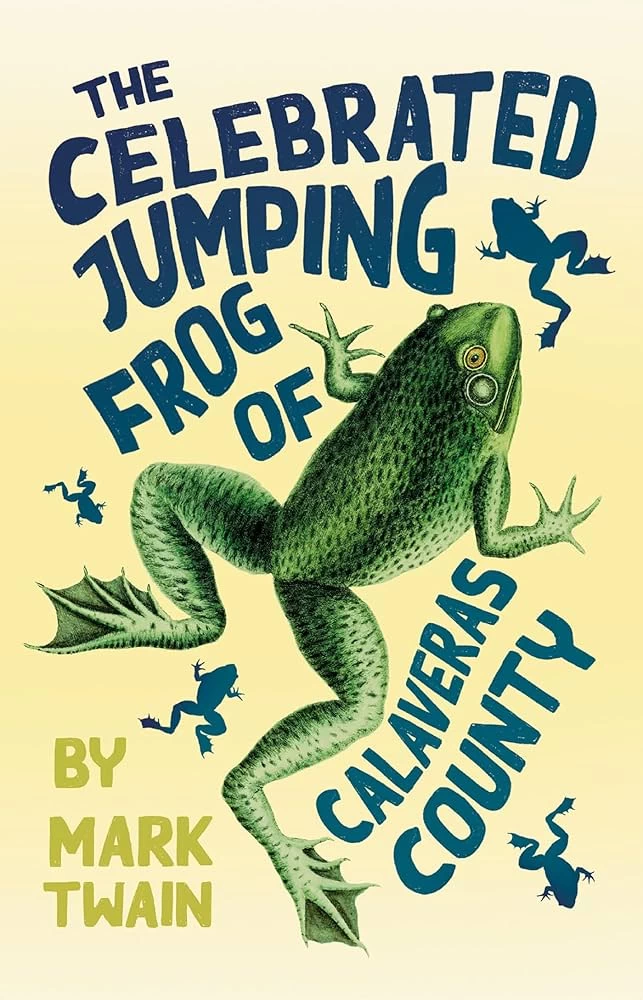Mark Twain’s short story The Celebrated Jumping Frog of Calaveras County, first published in 1865, is a quintessential example of American humor and satire. With its roots in the tradition of tall tales, the story showcases Twain’s distinctive narrative style, using humor to critique human nature and the absurdity of pride. Set in the fictional town of Calaveras County, the story centers around a man named Smiley and his prized frog, who becomes the focal point of a competition that reveals the power of deception and human gullibility. The story, which helped launch Twain’s career as a writer, remains a beloved piece of American literature. In this article, we will explore the major themes of The Celebrated Jumping Frog of Calaveras County, its characterization, and its influence on American literature.
Plot Summary of The Celebrated Jumping Frog of Calaveras County
The story is narrated by an unnamed outsider who visits a small mining town in California. The narrator is tasked with finding a man named Simon Wheeler, who is known for telling long-winded stories. When the narrator approaches Wheeler, he is regaled with the tale of a man named Smiley, a local figure known for his love of betting and training animals to perform tricks.
Smiley’s most famous animal is a frog named Dan’l Weber, whom Smiley has trained to jump in a race. The story goes that Smiley once used Dan’l Weber in a bet with a man who challenged him to a frog-jumping contest. Smiley bet $40 that his frog could jump higher than the challenger’s frog, but the challenger, being sly and crafty, secretly fed Smiley’s frog buckshot, which weighed it down and prevented it from jumping. When the race began, Dan’l Weber was unable to jump, and Smiley lost the bet.
The story is humorous not only because of the absurdity of the situation but also because of the narrator’s obliviousness to the fact that he has been taken in by Wheeler’s exaggerated storytelling. Twain’s use of dialect, humor, and irony serves to create a memorable tale of wit, deception, and the folly of human pride.
Major Themes in The Celebrated Jumping Frog of Calaveras County
1. Deception and Trickery
A central theme in The Celebrated Jumping Frog of Calaveras County is the idea of deception. Smiley’s frog, Dan’l Weber, is the vehicle through which a cunning trick is played. The antagonist of the story—the man who tricks Smiley—uses deceit to ensure that his frog wins the race, illustrating how easily people can be manipulated by their own pride and overconfidence.
The story presents a satirical commentary on human nature, particularly the tendency to place excessive faith in one’s own abilities and the consequences of this arrogance. Smiley’s blind trust in Dan’l Weber’s abilities blinds him to the possibility of being deceived. This theme of deception is underscored by the humorous way in which Twain presents the story, highlighting the silliness of Smiley’s misplaced confidence and the trickster’s cunning.
2. Human Folly and Pride
The story is a critique of human folly, particularly the pride Smiley takes in his frog and his belief that he is invincible when it comes to betting. Smiley’s obsession with winning, and his subsequent downfall when the frog fails to perform, illustrates the dangers of hubris—when people overestimate their own abilities and become too confident in their success.
Twain uses Smiley’s character to expose the ridiculousness of pride. Smiley’s belief that his frog is the best reflects his inflated sense of self-worth. He is convinced that his frog will triumph, and it is only when the frog fails that Smiley realizes the extent of his own delusion. This theme speaks to the broader human tendency to let pride cloud judgment and lead to failure.
3. Irony and Humor
One of the defining features of The Celebrated Jumping Frog of Calaveras County is its use of irony and humor. The story is filled with moments of comic absurdity, such as the fact that Smiley believes his frog is the best jumper in the world, despite the fact that the frog’s abilities are ultimately irrelevant to the outcome of the race.
The story’s humor is also found in the way it pokes fun at the seriousness with which people take their betting competitions. Smiley’s investment in the race is so deep that he does not even consider the possibility of losing, making his eventual defeat all the more ironic. The story highlights the folly of putting too much stock in trivial matters, such as betting on a frog race, and suggests that the more serious consequences of life are often ignored in favor of such absurdities.
4. The Role of Storytelling
Twain’s story is also a commentary on the nature of storytelling itself. The narrator, who is listening to Simon Wheeler’s tale, is caught up in the tall tale tradition, where the lines between truth and fiction are deliberately blurred for comedic effect. The exaggerated nature of Wheeler’s narrative—especially his lengthy, drawn-out descriptions and his focus on minute details—mocks the art of storytelling as a way of entertaining and deceiving an audience.
Simon Wheeler’s storytelling style is characterized by humor and embellishment, and the narrator’s willingness to listen attentively to the story demonstrates how people are often captivated by tales, no matter how far-fetched they may seem. Twain uses this device to demonstrate how storytelling itself can be an act of deception, revealing the ways in which people often prefer the excitement of a good yarn over the truth.
Characterization in The Celebrated Jumping Frog of Calaveras County
1. Simon Wheeler
Simon Wheeler is a talkative, rather unremarkable man who becomes the storyteller of the piece. His role in the story is crucial, as he is the one who spins the tale of Smiley and his frog. Wheeler is characterized by his drawn-out storytelling style, which plays a key role in setting the tone of the narrative. He is a man of few pretensions, content to recount local stories without much regard for whether his audience believes him. Wheeler’s character serves as the vehicle for Twain’s exploration of humor and exaggeration.
2. Smiley
Smiley, the central character of the story, is depicted as a proud and somewhat foolish man. He is utterly convinced that his frog, Dan’l Weber, is the best jumper in the world, and his belief in his frog’s abilities becomes his undoing. Smiley is a classic example of the prideful individual whose overconfidence leads to a fall from grace. Twain uses Smiley’s character to demonstrate the absurdity of human pride and the way people often get caught up in trivial pursuits without considering the consequences.
3. The Narrator
The unnamed narrator, who is the outsider in the story, is an essential part of Twain’s comedic structure. His naivety and failure to recognize the absurdity of Wheeler’s tale mirror the gullibility of Smiley. The narrator’s willingness to listen to Wheeler’s long-winded story without questioning its plausibility further underscores Twain’s theme of deception and the art of storytelling.
Legacy and Influence of The Celebrated Jumping Frog of Calaveras County
The Celebrated Jumping Frog of Calaveras County is often credited as the story that helped launch Mark Twain’s career and establish him as one of the most influential American writers. Twain’s use of dialect, humor, and wit in the story marked a departure from the more formal writing of the time and introduced a style that would become his trademark.
The story also holds a significant place in the history of American humor, blending elements of the tall tale tradition with social commentary. Twain’s ability to create humor from ordinary situations and to turn them into critiques of human nature has had a lasting impact on American literature, influencing generations of writers who sought to explore the absurdities of life through humor.
Conclusion
The Celebrated Jumping Frog of Calaveras County is a humorous, satirical story that explores themes of deception, pride, and the power of storytelling. Twain’s clever use of irony, humor, and dialect serves to create a lighthearted but thought-provoking commentary on human nature. Through the character of Smiley and his ill-fated bet with the frog, Twain highlights the folly of overconfidence and the ways in which people can be easily deceived. The story remains a classic example of American humor and continues to entertain readers with its wit, charm, and timeless themes.










 نکات طلایی یادگیری زبان،
نکات طلایی یادگیری زبان، 


